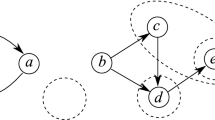Abstract
The efficiency of almost all theorem proving methods suffers from a phenomenon called duplication of instances of clauses. In this paper, we present a novel technique, called the hyper-linking strategy, to eliminate such duplication. This strategy is complete for the full first-order predicate calculus. We show the effectiveness of this strategy by comparing it with other proving methods. We give empirical evidence that both the Davis-Putnam procedure and the hyper-linking strategy are comparable to each other and better than other common theorem proving strategies on propositional calculus problems. The fact that the Davis-Putnam procedure is faster than resolution and other common methods on propositional problems seems not to be appreciated by a large segment of the theorem proving community. Also, we give empirical evidence that the hyper-linking strategy is better than other common theorem proving methods on near-propositional problems like logic puzzles. We attempt to explain the superior behavior of the hyper-linking strategy and the Davis-Putnam procedure by examining the kinds of duplication that can occur during the search with the different methods. In addition, we show the completeness of the hyper-linking strategy combined with several support strategies.
Similar content being viewed by others
References
Andrews, P. B., ‘Theorem proving via general matings’, Journal of the Association for Computing Machinery 28, 193–214, (1981).
Applied Logic Systems, Inc., ALS Prolog User's Guide and Reference Manual, Syracuse, New York, March 1988.
Bibel, W., Automated Theorem Proving, Vieweg (1982).
Chang, C. and Lee, R., Symbolic Logic and Mechanical Theorem Proving, Academic Press, New York (1973).
Cook, S.A., ‘The complexity of theorem-proving procedures’, In Proceedings of the 3rd Annual ACM Symposium on Theory of Computing (1971) pp. 151–158.
Davis, M., ‘Eliminating the irrelevant from mechanical proofs’, In Proceedings Symp. of Applied Math, (1963) Vol. 15, pp. 15–30.
Davis, M. and Putman, H., ‘A computing procedure for quantification theory’, Journal of the Association for Computing Machinery 7, 201–215 (1960).
de Kleer, J., ‘An assumption-based TMS’, Artificial Intelligence 28, 127–162 (1986).
de Kleer, J., ‘A comparison of ATMS and CSP techniques’, In Proceedings of 11th International Joint Conference on Artificial Intelligence, (1989) pp. 290–296.
Gilmore, P.C., ‘A proof method for quantification theory’, IBM Journal of Research and Development 4, 28–35 (1960).
Kowalski, R., ‘A proof procedure using connection graphs’, Journal of the Association for Computing Machinery 22, 572–595 (1975).
Lee, S.-J., CLIN: An Automated Reasoning System Using Clause Linking. PhD thesis, University of North Carolina at Chapel Hill, 1990.
Lee, S.-J. and Plaisted, D., ‘New applications of a fast propositional calculus decision procedure’, In Proceedings of the 8th Biennial Conference of Canadian Society for Computational Studies of Intelligence, pp. 204–211 (1990).
D. Loveland, Automated Theorem Proving: A Logical Basis, North-Holland, New York (1978).
Lusk, E. and Overbeek, R., ‘Non-Horn problems’, Journal of Automated Reasoning 1, 103–114 (1985).
McAllester, D., ‘An outlook on truth maintenance’, Technical Report AIM-551, Artificial Intelligence Laboratory, MIT, Cambridge, MA (1980).
McAllester, D., ‘Reasoning utility package user's manual’. Technical Report AIM-667, Artificial Intelligence Laboratory, MIT, Cambridge, MA (1982).
McCune, W.W., Otter 1.0 User's Guide. Mathematics and Computer Science Division, Argonne National Laboratory, Argonne, Illinois (1989).
Murray, N. and Rosenthal, E., ‘DISSOLVER: A dissolution-based theorem prover, system abstract, In Proceedings of the 10th International Conference on Automated Deduction, pp. 665–666 (1990).
Nie, X. Inplementation Techniques in Automatic Theorem Proving. PhD thesis, University of North Carolina, at Chapel Hill, 1989.
Nie, X and Plaisted, D., ‘A complete semantic back chaining proof system’, In Proceedings of the 10th International Conference on Automated Deduction (1990).
Ohlhach, H.J. and Schmidt-Schauss, M., ‘The lion and the unicorn’, Journal of Automated Reasoning 1, 327–332 (1985).
Pelletier, F.J., ‘Seventy-five problems for testing automatic theorem provers’, Journal of Automated Reasoning 2, 191–216 (1986).
Plaisted, D., ‘Non-Horn clause logic programming without contrapositives’, Journal of Automated Reasoning 4, 287–325 (1988).
Plaisted, D. and Lee, S.-J., ‘Inference by clause linking’, Technical Report TR90–022, University of North Carolina-Chapel Hill, Chapel Hill, NC (1990).
Prawitz, D., Prawitz, H. and Voghera, N., ‘A mechanical proof procedure and its realization in an electronic computer’, Journal of the Association for Computing Machinery 7, 102–128 (1960).
Robinson, J., ‘Theorem proving on the computer’, Journal of the Association for Computing Machinery 10, 163–174 (1963).
Robinson, J., ‘A machine-oriented logic based on the resolution principle’, Journal of the Association for Computing Machinery, 12 23–41 (1965).
Sterling, L. and Shapiro, E., The Art of Prolog, MIT Press, Cambridge, Massachusetts (1986).
Stickel, M.E., ‘A Prolog technology theorem prover: Implementation by an extended prolog compiler’, Journal of Automated Reasoning, 4, 353–380 (1988).
Wos, L., Overbeck, R., Lusk, E. and Boyle, J., Automated Reasoning: Introduction and Applications, Prentice Hall, Englewood Cliffs, N.J. (1984).
Wos, L., Robinson, G. and Carson, D., ‘Efficiency and completeness of the set of support strategy in theorem proving’, Journal of the Association for Computing Machinery 12, 536–541 (1965).
Author information
Authors and Affiliations
Additional information
This research was partially supported by NSF under grant CCR-8802282.
Rights and permissions
About this article
Cite this article
Lee, SJ., Plaisted, D.A. Eliminating duplication with the hyper-linking strategy. J Autom Reasoning 9, 25–42 (1992). https://doi.org/10.1007/BF00247825
Received:
Accepted:
Issue Date:
DOI: https://doi.org/10.1007/BF00247825




